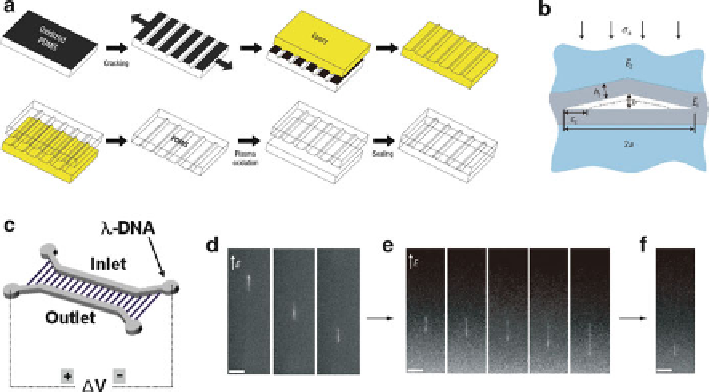Biomedical Engineering Reference
In-Depth Information
Fig. 7.23
DNA manipulation on structurally adjustable elastomeric nanochannels. (
a
) Fabrication
process: A PDMS slab exposed to oxygen plasma is stretched to generate linear nanoscale cracks;
the nanocracks are replicated onto ultraviolet-curable epoxy; PDMS prepolymer is cast against the
epoxy mold to generate negative relief patterns of nanochannels; the PDMS substrate is briefly
oxidized and sealed against an oxidized PDMS slab to form an array of enclosed nanochannels.
(
b
) The cross section of relaxed nanochannels can be approximated as an isosceles triangle with
an average base length of 688 nm (
2a
) and an average height of 78 nm (
h
). (
c
) Entire layout of
the DNA manipulation device. DNA is introduced into the inlet with width of 100
m, depth
of 50
m, and length of 7 mm, and flows through the parallel nanochannels under electric field.
(
d
) Electrophoretic migration of a partially extended 48.5-kbp-long
œ
-phage DNA in a relaxed
cm
1
(time interval between frames
nanochannel by 34.5 V
0.8 s).
E
, electric field. (
e
) Channel
deformation at 22 kPa resulted in further stretching of the DNA to 13.6
D
m at the same electric
field (time interval between frames D 0.6 s). (
f
) Removal of compression after the electric field was
switched off, causing the DNA molecule to relax to its original length. Scale bars, 5 m (Reprinted
with permission from Macmillan Publishers Ltd: Ref. [
100
], copyright 2007)
7.3.3
Weighing
Micro- and nanocantilever biosensors as a new kind of platform measure mechanical
response changes arising from specific interactions between biomolecules including
antigen/antibody and oligonucleotides. It is rapid, label-free, sensitive, and small,
which is suitable for POCT. Some reports paid attention to the combination between
cantilever sensors and microfluidic channels [
101
] and gave a few attempts to
close the final aim of
TAS including sample preparation, fluid control, and signal
readout. There are many challenges, and concerns remained. Especially, surface
treatment for the sensor surface is critical to ensure the specificity by suppressing
nonspecific binding of biomolecules [
102
].
Various cantilever biosensors can be used for a wide range of biological targets,
such as nucleic acids, proteins, viruses, and bacteria. Cantilever biosensors primarily

Search WWH ::

Custom Search